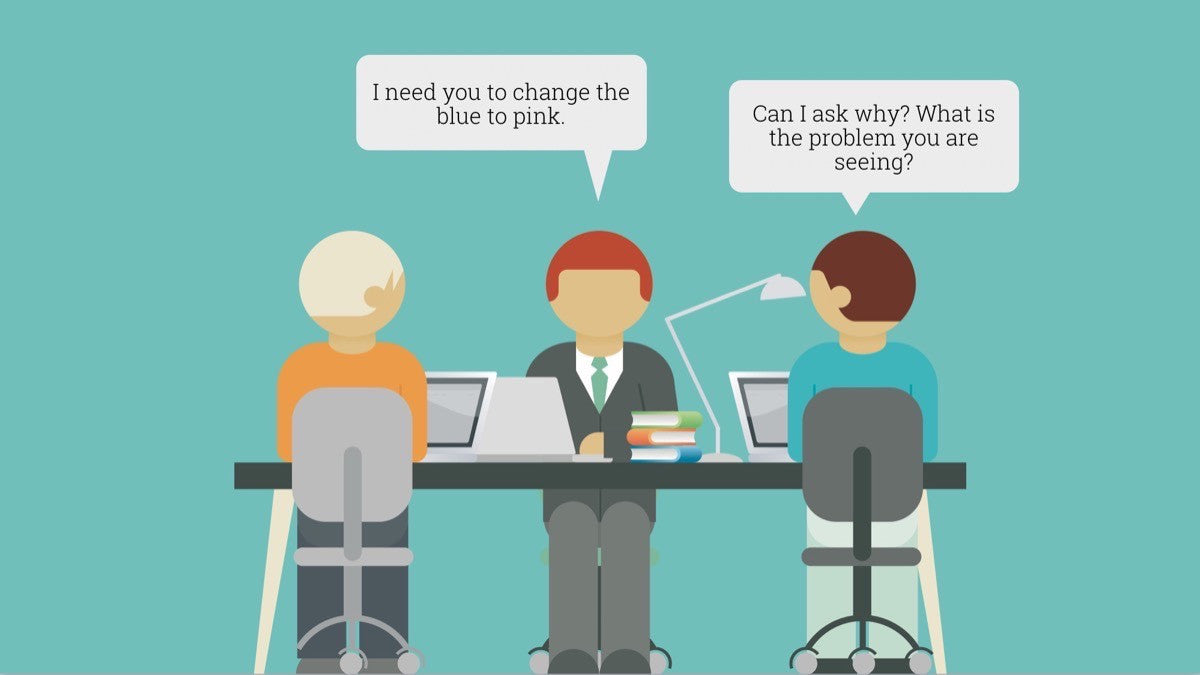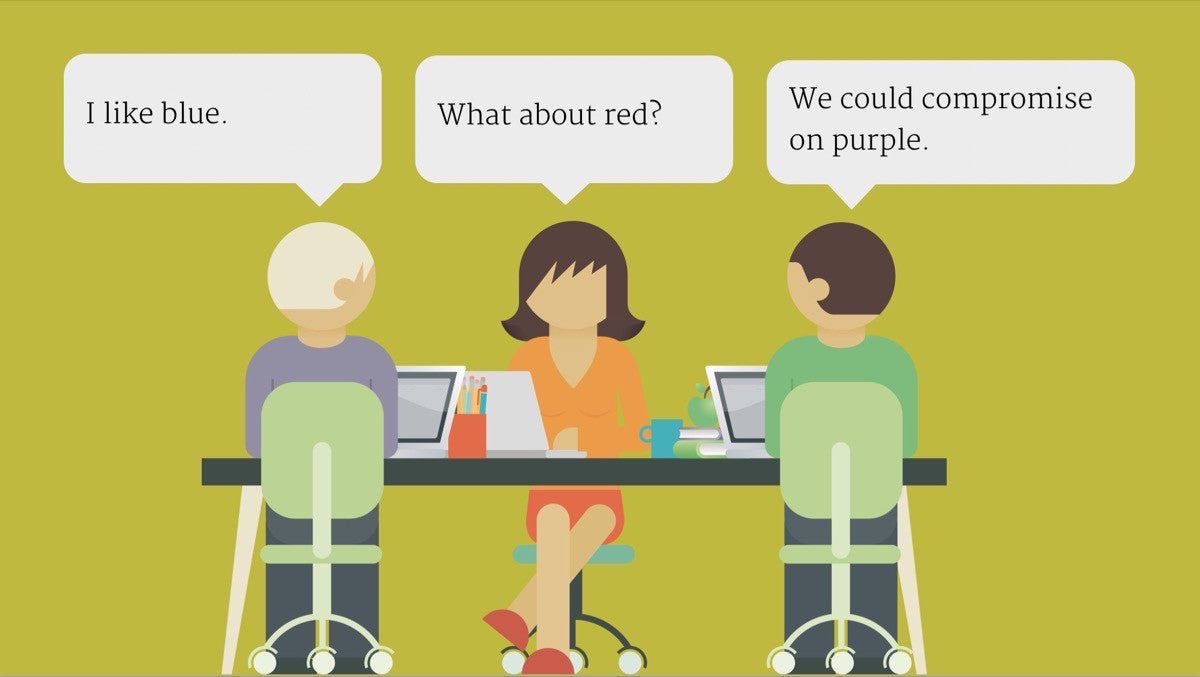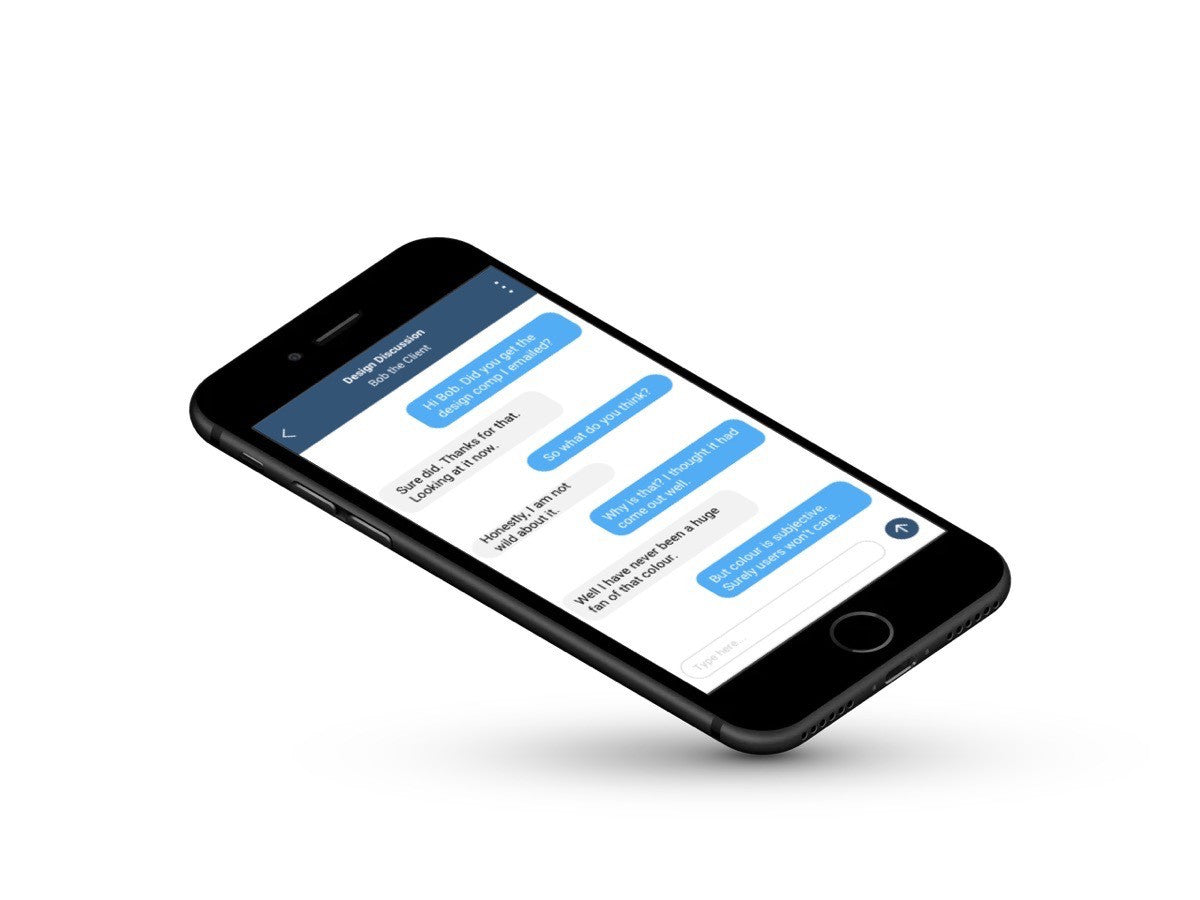One of the biggest challenges we face as digital professionals is convincing others. Whether our boss, clients, or colleagues, it can be tough, especially with design. But it is possible.
Whether our boss, clients, or colleagues, it can be tough, especially with design. But it is possible.
Everybody has an opinion about design. We all know what we like. But we definitely know what we hate. These strong opinions about design can be frustrating for designers. It can lead us to compromised design that pleases nobody. But worse than that, it leads to endless iterations. Iterations that are time consuming and expensive.
It can lead us to compromised design that pleases nobody. But worse than that, it leads to endless iterations. Iterations that are time consuming and expensive.
Yet nobody prepares us for these battles. We are ill equipped to win over colleagues or clients. But there are techniques that can help. They will help avoid the demoralizing feeling that comes with never-ending iterations.
It begins before you even start designing.
And to help your design process, be sure to check out our list of funny lorem ipsum generators.
You might also like: You’re Nothing Special: How to Stand Out in a Crowded Marketplace.
1. Lay the groundwork
Some careful planning will make your life a lot easier when it comes to getting design approval. If you prepare your client and set their expectations, it will be easier to convince them.
If you prepare your client and set their expectations, it will be easier to convince them.
For a start, define their role.
Define the client’s role
Most clients are not used to approving design. Those that are have often picked up some bad habits, especially from working with print. That is why it’s important to make your expectations clear from the outset. I do this in two ways.
- I make them responsible for ensuring the design meets business goals and user needs. This focuses them on the right kind of areas, rather than judging a design by their personal opinion.
- Second, I explain that their job is to identify problems and my job is to find solutions. This discourages them from making comments such as “change the blue to pink.” Instead, it encourages them to identify the underlying problem. A problem such as “I am worried our pre-teen girl audience will hate the blue.” This allows me to suggest a variety of solutions beyond changing the site to pink.

Once you have defined the client’s role, you need to do something counter-intuitive.
Get the client involved early
Because we fear what clients will say about our design, we tend to exclude them from the process. We wait until the design is as good as we can make it before presenting it to the client.
Because we fear what clients will say about our design, we tend to exclude them from the process. We wait until the design is as good as we can make it before presenting it to the client.
Our hope is to minimize the impact they might have with their feedback. Unfortunately, this is the worst thing we can do as it can result in one of the following scenarios:
-
The client feels excluded and ignored. This makes them resentful and more likely to reject the design.
-
The client has no sense of ownership. It is your design and not theirs. Because they aren’t invested in the design they feel freer to criticize it.
-
The client feels surprised (and nobody likes surprises). Being presented with a completed design is always going to surprise. It will rarely be what they had in their heads, and so they will tend to be unhappy.
-
You are on the defence. Because you have invested so much time and effort into the design, you are desperate for the client to accept it. This means you will not respond well to criticism.
- You haven't educated the client about design. The client wasn't involved in its creation. This means they don't understand the thinking behind the design.
Instead, we need to get the client involved early. To get them creating moodboards, deciding on tone of voice and even wireframing key pages. This will educate them and engage them, reducing the chance of them rejecting a design. Also when they see the final design, it won’t come as a big surprise.
To get them creating moodboards, deciding on tone of voice and even wireframing key pages. This will educate them and engage them, reducing the chance of them rejecting a design. Also when they see the final design, it won’t come as a big surprise.
This brings us to the moment of presenting the design to the client.
You might also like: 12 Rules of Engagement When Running Design Critiques from NASDAQ’s Aaron Irizarry.
2. Present your design
Presenting a design to a client can be a terrifying and soul destroying prospect. But there are things you can do to make the process less painful. Things that will also improve the chances of the client signing off on the design.
This begins by making the effort to actually present the design.
Always explain your design
The worst thing you can do is email the client your design and sit back. With no context, background, or explanation they will solely rely on personal opinion.
With no context, background, or explanation they will solely rely on personal opinion.
Instead, present in person if at all possible. Also, ensure you present to all decision makers and anybody who might influence them.

If face-to-face presentation is not possible, consider recording a video. One where you talk through the design. This ensures people will not see the design without knowing why you made the decisions you did. Also, if decision makers show the design to other people, they will get your presentation too.
But what should you say when you present?
Reference your work with the client
When presenting the design always reference any work you did with the client. If you worked with the client on wireframes or moodboards, make sure you point out how the design uses that work.
This makes the client feel like they were a part of creating the design. If they feel like it is their design, they are more likely to approve it and defend it to colleagues.
Don't stop with the design work you did with the client. Also reference audiences, business goals, and anything else you agreed on with the client. This will reinforce the idea that the design is the natural result of the journey you have been on together.
This will reinforce the idea that the design is the natural result of the journey you have been on together.
But don't only talk about how you’ve taken on the client’s feedback. You will also need to discuss when you ignored it.
Don’t avoid the difficult issues
Sometimes you will do something that you know the client won’t like. Perhaps they wanted a certain color palette, and you went in another direction. Or, you know they will complain the logo isn’t big enough.
In such circumstances we tend to hope for the best, and pray they don’t mention it. But that is the worst thing we can do.
Once somebody says they don’t like something, they will rarely back down. People don’t like to allow somebody else to win an argument, especially if that person is working for them.
But if you preempt these issues, you give the client the chance to consider your argument. It gives them a chance to agree without losing face.
But if you preempt these issues, you give the client the chance to consider your argument. It gives them a chance to agree without losing face.
Imagine for instance that you suspect the client might not like the color choice. Don’t wait to see if they raise it. Bring it up yourself. Say that you agonized over the color choice. That you know some people might not like it. Then go on to explain your reasons. But make sure these reasons are not personal opinion. Frame those reasons around testing you have carried out or research online. Reference color theory or refer to similar choices others have made. Anything to move the conversation away from personal preferences.
Of course, no matter how well you present, sooner or later the client has to provide their feedback. You cannot put off the dreaded moment any longer. So how do you gather the clients feedback in the right way?
You might also like: How to Give Good Creative Feedback.
3. Control the feedback process
Things can go wrong, even when you present your design well. That is because we can lose control of the feedback process. This is especially true when dealing with more than one stakeholder.
Avoid group discussions
If you present the design to a group of people, don’t get into a conversation about the design in the room. This is because the group will have different opinions. This leads to them discussing compromises. At this point, you lose control of the design and the whole thing turns into design by committee.

If possible, present the design to stakeholders one at a time. If that’s not possible, suggest people feedback after they have had time to consider it. This means they are not discussing it as a group in the meeting. Also, encourage each of them to feedback to you, not your primary point of contact.
If that’s not possible, suggest people feedback after they have had time to consider it. This means they are not discussing it as a group in the meeting. Also, encourage each of them to feedback to you, not your primary point of contact.
Make sure all the feedback comes to you
A common mistake I see designers making is that they ask the client to gather all the feedback from internal stakeholders, and then send it through to you. This creates two problems:
- You don’t get to understand the thinking behind the comments.
- You don’t have an opportunity to challenge the comments.
But there also is a big advantage to speaking to stakeholders individually yourself. It means that you are the only person who knows all the comments. It allows you to pick and choose which comments you act upon and which you ignore.
Another way of controlling the feedback is to ask specific questions.
Ask for specific types of feedback
Never ask a client what they think of a design. If you do they will give you their personal opinion and that is not useful in improving the design. Instead, ask them specific questions. This will ensure the feedback you get back is actually useful.
If you do they will give you their personal opinion and that is not useful in improving the design. Instead, ask them specific questions. This will ensure the feedback you get back is actually useful.
Never ask a client what they think of a design. If you do they will give you their personal opinion and that is not useful in improving the design.

The exact questions you ask will vary depending on the project. But there are three you should always include:
- Does this final design reflect the work we did together in the development process?
- Will this design help the organization achieve its business goals?
- Does this design meet the needs of your target audience?
If the client answers yes to all three questions, they have little reason to reject the design. It may not ‘feel’ right to them, they may want to tweak it, but you have proved you have delivered.
No magic formula
Let me be honest. The advice in this article does not always work. Sometimes you encounter people determined to micro-manage the design. Determined the design will meet their personal preferences. But these people are much rarer than you think. Most of the time, with some careful management, you can avoid endless iterations. You can end up with a design you are proud of and that the client appreciates.
Read more
- Top Ecommerce Web Design Trends from January
- Top Ecommerce Web Design Trends for March
- 13 Web Design Trends to Watch in 2020
- Designing With Customer Service In Mind Above All Else
- Top Ecommerce Resources for August
- How to Build a Winning Ecommerce Design: An Interview with Vitaly Friedman
- Working With a Grid Layout: How Breaking the Grid Can Create Memorable Experiences for Clients
- Top 13 Web Design Conferences You Should Attend in 2016
- 4 Things to Consider When Designing Wholesale Stores for Clients
- 8 Best Practices for Designing an Ecommerce Site that Converts
What do you think of our strategies? Tell us what you think in the comments section below!

